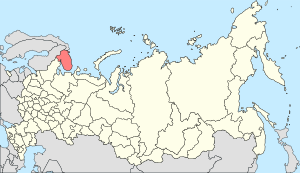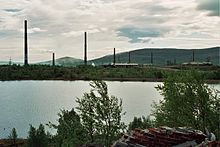Murmansk Oblast: Difference between revisions
m r2.6.4) (robot Adding: kbd:Мурманск област |
|||
| Line 123: | Line 123: | ||
[[File:Monchegorsk factories.jpg|thumb|A [[Norilsk Nickel]] plant (formerly, [[Severonikel]]) in [[Monchegorsk]]]] |
[[File:Monchegorsk factories.jpg|thumb|A [[Norilsk Nickel]] plant (formerly, [[Severonikel]]) in [[Monchegorsk]]]] |
||
The economy of the region is export-oriented. Main export items are nickel products, apatite concentrate, copper and copper products, aluminium and ferrous metals.<ref name="barentsinfo">[http://www.barentsinfo.org/?newsid=8370&deptid=13875&languageid=4&news=1 Positive economic development in Murmansk]</ref> The Murmansk Region produces almost 100 percent of Russia's apatite concentrate (3.7 million tons in 1998), 43 percent of nickel, 15 percent of copper, 12 percent of iron ore and iron ore concentrate (17.7 million and 6.4 million tons in 1998), and 40 percent of cobalt.<ref name="fas"/><ref name="amk"/> |
The economy of the region is export-oriented. Main export items are nickel products, [[apatite concentrate]], copper and copper products, aluminium and ferrous metals.<ref name="barentsinfo">[http://www.barentsinfo.org/?newsid=8370&deptid=13875&languageid=4&news=1 Positive economic development in Murmansk]</ref> The Murmansk Region produces almost 100 percent of Russia's apatite concentrate (3.7 million tons in 1998), 43 percent of nickel, 15 percent of copper, 12 percent of iron ore and iron ore concentrate (17.7 million and 6.4 million tons in 1998), and 40 percent of cobalt.<ref name="fas"/><ref name="amk"/> |
||
The largest companies of the region - constituting 90% of the oblast's production - are [[Pechenganickel]], [[Olcon]], the [[Kola Nuclear Power Plant]], [[Sevrybkholodflot]], [[Murmanrybprom]], [[Murmansk Trawl Fleet]] and [[Murmansk Shipping Company]].<ref name="fas"/> |
The largest companies of the region - constituting 90% of the oblast's production - are [[Pechenganickel]], [[Olcon]], the [[Kola Nuclear Power Plant]], [[Sevrybkholodflot]], [[Murmanrybprom]], [[Murmansk Trawl Fleet]] and [[Murmansk Shipping Company]].<ref name="fas"/> |
||
Revision as of 14:20, 16 May 2011
Murmansk Oblast | |
|---|---|
| Мурманская область | |
|
| |
 | |
| Country | Russia |
| Federal district | Northwestern[1] |
| Economic region | Northern[2] |
| Administrative center | Murmansk |
| Government | |
| • Body | Oblast Duma[3] |
| • Governor[5] | Dmitry Dmitriyenko[4] |
| Area | |
| • Total | 144,900 km2 (55,900 sq mi) |
| • Rank | 26th |
| Population | |
| • Total | 796,100 |
| • Estimate (2018)[8] | 753,557 (−5.3%) |
| • Rank | 62nd |
| • Density | 5.5/km2 (14/sq mi) |
| • Urban | 92.8% |
| • Rural | 7.2% |
| Time zone | UTC+3 (MSK |
| ISO 3166 code | RU-MUR |
| License plates | 51 |
| OKTMO ID | 47000000 |
| Official languages | Russian[10] |
| Website | http://www.gov-murman.ru/ |
Murmansk Oblast (Russian: Му́рманская о́бласть, Murmanskaya oblast) is a federal subject of Russia (an oblast), located in the northwestern part of Russia. Its administrative center is the city of Murmansk.
Geography
Geographically it is located mainly on the Kola Peninsula, and it is a part of the larger Lapland region that spans over four countries. Murmansk Oblast borders Karelia, Finnmark County in Norway and Lapland Province in Finland. Norrbotten County in Sweden is also located nearby (300 km).
History
The oblast was established on May 28, 1938, from Murmansk Okrug of Leningrad Oblast (comprising the city of Murmansk, Kirovsky, Kolsky, Lovozersky, Polyarny, Saamsky, Teribersky, and Tersky Districts) and Kandalakshsky District of the Karelian ASSR.[11]
Administrative divisions
Demographics
As of the 2002 Census, 92.2% of the oblast's population live in urban areas.[12] The most populous city is the Oblast's administrative center, Murmansk, with 336,137 inhabitants.[12] Other large cities and towns include Severomorsk, Apatity, Kandalaksha, Monchegorsk, and Kirovsk.

According to the (2002 Census), the ethnic composition of the oblast was as follows:
- Russians: 85.2%
- Ukrainians: 6.4%
- Belarusians: 2.3%
- Tatars: 0.9%
- Azeris: 0.5%
- Chuvash: 0.3%
- Mordvins: 0.3%
- Karelians: 0.3%
- Komi: 0.2%
- Moldavians: 0.2%
- Armenians: 0.2%
- Saami: 0.2%
- other groups, none of which accounts for more than 0.2% of the population
- did not state ethnicity: 1.2%
Vital statistics in 2007
- Birth rate: 10.18 per 1000 (average for Russia is 11.30)
- Death rate: 11.68 per 1000
- Net migration: -5.6 per 1000
- NGR: -0.15% per annum
- PGR: -0.71% per annum
Vital statistics for 2009
In 2009, the urban areas were marked by natural population decline (-0.16% per year) and the rural ares were marked by natural population growth (+0.35% per year).[13]
Economy
The Murmansk Oblast is very rich in natural resources and has deposits of over 700 minerals.[14] The main industries of the region are in the sphere of raw material extraction and basic processing.[15] The largest industries are metallurgy (36,6%), electric power-production (22,9%) and food-industry, including fishing (13,7%).[16][17] The icefree port of Murmansk plays an important role in marine transportation in Russia, and the oblast has a 41% share of the total Russian marine transport market.[18][19] The fishing industry is among the most profitable in the region, supplying 16% of Russia's total fish production. Murmansk is a key base for three fishing fleets, including Russia's largest, the Murmansk Trawl Fleet.[15]

The economy of the region is export-oriented. Main export items are nickel products, apatite concentrate, copper and copper products, aluminium and ferrous metals.[18] The Murmansk Region produces almost 100 percent of Russia's apatite concentrate (3.7 million tons in 1998), 43 percent of nickel, 15 percent of copper, 12 percent of iron ore and iron ore concentrate (17.7 million and 6.4 million tons in 1998), and 40 percent of cobalt.[14][16]
The largest companies of the region - constituting 90% of the oblast's production - are Pechenganickel, Olcon, the Kola Nuclear Power Plant, Sevrybkholodflot, Murmanrybprom, Murmansk Trawl Fleet and Murmansk Shipping Company.[14]
Large oil and gas resources have been discovered on the shelf of the Barents sea, including the massive Shtokman field - one of the world's largest gas fields with estimated reserves of 3.8 trillion cubic meters.[14][19][20] Prospective oil fields could potentially yield up to 40 million tons in the next 10–15 years.[14] However, the development of the oil and gas resources will require considerable investment.[14]
In 2006, the Murmansk Oblast's gross regional product was 141.9 billion rubles, which amounts to about 0.4% of the Russian GDP.[18] Unemployment in 2006 was 3,4%.[18] GRP pro capita in 2007 was 225 044 rubles.[21] Regional automobile code is 51.
Governors of Murmansk Oblast
| Name | Period |
|---|---|
| Yury Yevdokimov | Decemnber 1997 – March 21, 2009 |
| Dmitry Dmitriyenko | March 21, 2009 – Incumbent |
Chairmen of the Murmansk Oblast Duma
| Name | Period |
|---|---|
| Pavel Sazhinov | December 19, 1994 – 2007 |
| Yevgeny Nikora | March 26, 2007 – Incumbent |
Source:[22]
See also

References
- ^ Президент Российской Федерации. Указ №849 от 13 мая 2000 г. «О полномочном представителе Президента Российской Федерации в федеральном округе». Вступил в силу 13 мая 2000 г. Опубликован: "Собрание законодательства РФ", No. 20, ст. 2112, 15 мая 2000 г. (President of the Russian Federation. Decree #849 of May 13, 2000 On the Plenipotentiary Representative of the President of the Russian Federation in a Federal District. Effective as of May 13, 2000.).
- ^ Госстандарт Российской Федерации. №ОК 024-95 27 декабря 1995 г. «Общероссийский классификатор экономических регионов. 2. Экономические районы», в ред. Изменения №5/2001 ОКЭР. (Gosstandart of the Russian Federation. #OK 024-95 December 27, 1995 Russian Classification of Economic Regions. 2. Economic Regions, as amended by the Amendment #5/2001 OKER. ).
- ^ Charter of Murmansk Oblast, Article 13
- ^ Official website of the Governor of Murmansk Oblast. Dmitry Dmitriyenko, Governor of Murmansk Oblast Template:Ru icon
- ^ Charter of Murmansk Oblast, Article 14.1
- ^ "Сведения о наличии и распределении земель в Российской Федерации на 01.01.2019 (в разрезе субъектов Российской Федерации)". Federal Service for State Registration, Cadastre and Cartography. Archived from the original on 9 February 2022. Retrieved 29 August 2023.
- ^ Russian Federal State Statistics Service (2011). Всероссийская перепись населения 2010 года. Том 1 [2010 All-Russian Population Census, vol. 1]. Всероссийская перепись населения 2010 года [2010 All-Russia Population Census] (in Russian). Federal State Statistics Service.
- ^ "26. Численность постоянного населения Российской Федерации по муниципальным образованиям на 1 января 2018 года". Federal State Statistics Service. Retrieved 23 January 2019.
- ^ "Об исчислении времени". Официальный интернет-портал правовой информации (in Russian). 3 June 2011. Retrieved 19 January 2019.
- ^ Official throughout the Russian Federation according to Article 68.1 of the Constitution of Russia.
- ^ a b Президиум Верховного Совета СССР. Указ от 28 мая 1938 г. «Об образовании Мурманской области». Опубликован: "Ведомости Верховного Совета СССР", №7, 1938. (Presidium of the Supreme Soviet of the USSR. Decree of May 28, 1938 On Establishing Murmansk Oblast. ).
- ^ a b Федеральная служба государственной статистики (Federal State Statistics Service) (2004-05-21). "Численность населения России, субъектов Российской Федерации в составе федеральных округов, районов, городских поселений, сельских населённых пунктов – районных центров и сельских населённых пунктов с населением 3 тысячи и более человек[[Category:Articles containing Russian-language text]] (Population of Russia, its federal districts, federal subjects, districts, urban localities, rural localities—administrative centers, and rural localities with population of over 3,000)". Всероссийская перепись населения 2002 года (All-Russia Population Census of 2002) (in Russian). Federal State Statistics Service. Retrieved 2009-04-17.
{{cite web}}: URL–wikilink conflict (help) - ^ http://murmanskstat.gks.ru/moinfigures/population/demography/basicindicators/06.htm
- ^ a b c d e f "OVERVIEW OF MURMANSK REGION". Federation of American Scientists. Retrieved 2009-06-05.
- ^ a b Murmansk Oblast Globalsecurity.org
- ^ a b "Murmansk region". Häme Polytechnic. Retrieved 2009-06-05.
- ^ "Murmansk Region". Retrieved 2009-06-05.
- ^ a b c d Positive economic development in Murmansk
- ^ a b Economic Development in the Murmansk Region in 2007
- ^ UPDATE 1-Russia's Gazprom ups Shtokman reserves to 3.8 tcm
- ^ Валовой региональный продукт на душу населения Федеральная служба государственной статистики
- ^ Official website
Sources
- Мурманская областная Дума. Закон от 26 ноября 1997 г. «Устав Мурманской области», в ред. Закона №1448-01-ЗМО от 27 декабря 2011 г. «О внесении изменения в статью 58 Устава Мурманской области». Вступил в силу на двенадцатый день со дня официального опубликования в газете "Мурманский Вестник". Опубликован: "Мурманский Вестник", №235, стр. 6–7, 6 декабря 1997 г. (Murmansk Oblast Duma. Law of November 26, 1997 Charter of Murmansk Oblast, as amended by the Law #1448-01-ZMO of December 27, 2011 On Amending Article 58 of the Charter of Murmansk Oblast. Effective as of the day twelve days after the official publication in the Murmansky Vestnik newspaper.).
External links
 Media related to Murmansk Oblast at Wikimedia Commons
Media related to Murmansk Oblast at Wikimedia Commons- Info server of Murmansk Oblast
- News Site of Murmansk Oblast


